
Make family meals matter
Research and personal experience indicate that families greatly benefit from eating meals together on a regular basis. Families that dine together appreciate their food more, tend to eat healthier food and build stronger interpersonal bonds. But the hectic pace of daily life often makes it challenging for families to eat together. Most of us have busy lives filled with distractions, conflicting schedules and a baseline of unrelenting drudgery at home. (Can you tell I hate doing dishes?)
Although it might seem hard to carve out time to have a meal together, it’s important to try. Keep it simple at first — start with breakfast if you can’t manage dinner. Don’t block your efforts by worrying about recipes and making things perfect. Just set the intention to have enjoyable meals together more frequently. Whether you are getting started with family meals, or feel like your meals have fallen into a rut, here are some ideas for making family meals more enjoyable.
Invite other people over to dinner
I believe nothing does more to create a sense of community, connectedness and old-fashioned sociability than breaking bread with other people. This ancient human activity is a critical component of friendship and adds to our social well-being. My family hosts friends for brunch or dinner at least two times a week, and we go to other people’s houses at least once a week.
When you host other families for meals, you are teaching your children the art of hospitality. They learn to share their home and possessions, act as hosts/hostesses and bond with people other than family (i.e., the wider community). They also experience the exchange of resources and effort that happens when we feed people and they in return feed us. Nearly every morning our daughter asks, “Who’s coming to dinner tonight?” She loves it when other families come to dinner because meals with friends are more fun and (often) zany.
Try not to worry about what you serve, or whether your house is clean or your children “well-behaved enough.” Just invite people over and wing it. Conviviality is not a burden or social obligation. It’s entertaining, messy, chaotic and soul-affirming. Just like life!
Next: Create a meal that reflects your ethnic or cultural heritage
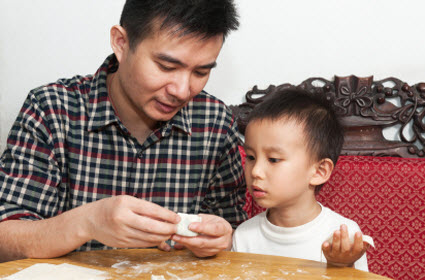
Create a meal that reflects your ethnic or cultural heritage
Make a meal from your country of origin or from your grandparents’ or great-grandparents’ culture. Do some food research with your kids to find out what your ancestors might have eaten in whatever timeframe interests you. Preparing a culture-based meal provides a great opportunity to bring out photos of relatives and tell family stories. You can also bring some good history books and atlases to the table and discuss the historical context for your relatives’ emigration (or your own). Cultural meals provide a great excuse to ditch your latest attempt at healthy eating and go for the gusto. (Pierogies! Goulash! Pork spareribs!)
Next: Serve breakfast for dinner

Serve breakfast for dinner
If you haven’t already discovered the joys of having breakfast for dinner, grab a pat of butter and give it a whirl. It’s pretty straightforward and nearly always a hit. Just make your favorite breakfast items, such as waffles, fruit salad, pancakes, bacon, eggs, sausage, and serve them for dinner. If you’re obsessed with serving something green at every meal because of those bossy-boots pediatricians, throw some spinach and peppers into an omelet, scramble or frittata. If you are a great crêpe maker, then by all means make them for dinner (with both savory and sweet fillings). And make a lot because I’ll be right over...
Next: Assemble dinner together

Assemble dinner together
Another easy way to make dinner more engaging is to let each person customize his or her meal. Just prepare a base food and encourage each person to add his/her own toppings. Self-assembled dinner is fun and less formal and is particularly good for picky kids. It also encourages culinary creativity. For example, my daughter put Honey Nut Cheerios on her cheese pizza one night. I grudgingly had to agree with her that the result was pretty tasty.
Pizza is the obvious choice for individual assembly, but also try tacos, burritos, sandwiches (subs and BLTs are great for DIY), pasta with multiple sauces, soups like posole, etc. You can step into classy times with a true smorgasbord or get a bit more complicated with roll-your-own Vietnamese fresh rolls or sushi. At brunch on the weekend put out a bunch of different ingredients for smoothies and let everyone make their own. If you do movie nights, set up a popcorn bar with spices, cheeses, chocolate sprinkles, etc.
Next: Designate certain nights for certain foods
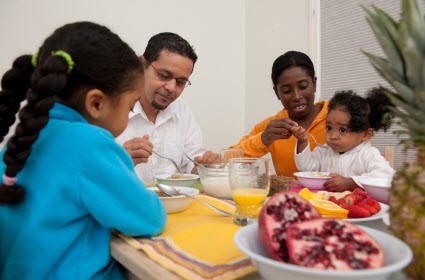
Designate certain nights for certain foods
Kids tend to prefer regularity and predictability in their food routine. They also like to feel included in family decisions and having their opinions respected. Dinner is a great place to give them a chance to make choices that affect the whole family, establishing in some cases new family rituals around food. For example:
- Let each kid pick the meal on a particular day of the week (or month). Find ways to get them involved in shopping for and preparing the meal so they can take some personal pride in the results.
- Take a cue from the classic school lunch menu and work with the kids to link each night of the week to a particular food (e.g., Taco Tuesday, Takeout Thursday, Pizza Friday). This helps immensely with menu planning, if you partake in such a practice.
- Dedicate one or more nights per month to trying new foods. Take the kids to a store and pick something they’ve never heard of and try it. This is particularly easy to do in the produce section of area grocery stores and at farmers markets — funky-looking exotic fruits (cherimoya, pummelo, ugli fruit, dragon fruit, the spiky and odorous durian!) and vegetables abound in all seasons.
- Go out to a restaurant and order something really daring off the menu. Have fun experimenting together! (See related article on introducing kids to ethnic foods.)
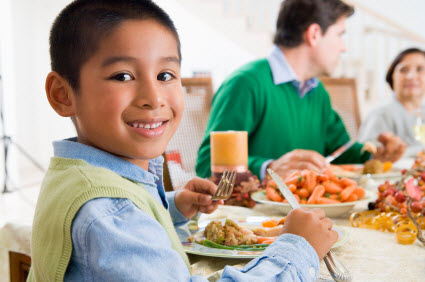
Fancy it up!
Kids love to play dress up. So, why not polish the silver and pull out the china Granny gave you, put on the dressy clothes, iron the cloth napkins, and make a fancy dinner? Serve classy or old-fashioned food, or even food from a bygone era (think Downton Abbey!). Eat by candlelight. Teach your kids the difference between a fish fork and a strawberry fork (and then teach me). Practice table manners and pretend the dinner is a dry run for a dinner with the queen. Take it a step further and print out menus and then take orders from the “patrons.”
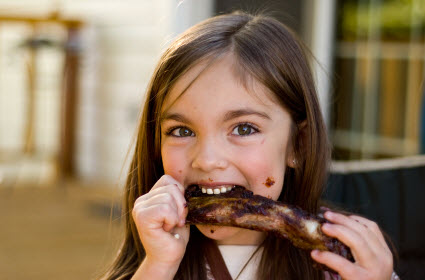
Eat with your hands
It’s so exciting when babies learn how to feed themselves. (“Look at that hand/eye coordination!”) But at some point we parents turn on the tots and tell them not to eat with their hands. It’s all very confusing for young children! So why not eat dinner with your hands now and again, even if what you are eating is not prototypical “hand” food? You can eat pretty much anything with your hands, as long as it’s not extremely hot (i.e., skip the lasagna). The kids will enjoy seeing their parents get messy, and for once the toddlers will feel, well, normal.
We celebrate winter solstice with friends by making a huge meal of baked salmon, salads, grains or pasta, and pie, and eating it with our hands. It’s fun, hilarious, messy, and very celebratory of the pagan past.
Next: Emphasize the art of dinner conversation

Emphasize the art of dinner conversation
Meaningful conversation and sharing are the foundation of a good relationship. Put some thought into ways that your family can improve the conversation around the table, whether it’s to play a game like Telephone or talk about the high/low points of each other’s day. If you need some help, here are some ideas for conversation starters. Meals are way more compelling when there’s something to do besides wolf down food and bicker.
Take time to define what family traditions you want to establish around moral and/or spiritual thoughts at the table. For example, some families say a blessing/grace before eating and/or hold hands. Maybe your family likes to discuss current events each night. Several families I know use the Rose, Thorn, and Bud. The Rose is the best part of your day. The Thorn is the worst part of your day, and the Bud is what you are looking forward to tomorrow. At our house, we go around the table and talk about something we’re thankful for that day. These kinds of practices help establish calm connection during the meal.
Basic good manners are required to create an atmosphere where conversation can take place. Younger kids need to stay in their seats and older kids should stay at the table, even if they’re done with their food. And everyone needs to listen to the person who’s talking. If your family is particularly prone to interruption, try passing around a “talking stick” to indicate who has the floor.
Next: Designate an official game night

Designate an official game night
It’s surprising how many families don’t engage in family game night, even though it’s easy and fun. Simply order some takeout, or make frozen pizza, and then after dinner, play cards, board games, Wii, or whatever your family likes to do together. You can even play some simple games (e.g., Pass the Pig or 20 Questions) at the table while you’re eating as a warm-up. Puzzles are also a fun family activity. Look for “family” puzzles that have different size pieces so younger kids can work the larger pieces and adults can tackle the smaller pieces. Whatever you decide to do, make it a regular occurrence. Game night is less about the games and more about establishing intentional family time together.
Next: Gather around a one-pot meal
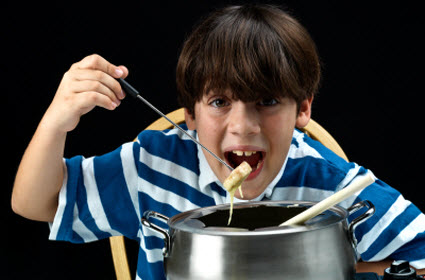
Gather around a one-pot meal
I’m a big fan of fondue and shabu shabu — centerpiece, one-pot meals that allow family members to gather around and share the food together. Eating out of the same pot encourages eye contact and you get to share the platter of dipping items. It’s funny to see people lose chunks of bread in the cheese, and chocolate fondue made right (unlike those oily fountains) will make your children swoon. Clearly, fondue pots get hot so this is an activity for older children (or you can feed smaller children separately). There’s a reason people are always smiling in old fondue ads. They’re having a good time!
Here are some additional resources on improving family meals:
- Time article summarizing research on family meals.
- New York Times article on the importance of family meals.
- Here’s a 30-day challenge to get family meals back on track.
- Tips for busy families from The Family Dinner Project.
- The Family Dinner, by Laurie David, producer of An Inconvenient Truth and proponent of the “back to the family table” movement (my words), is a manifesto (and related blog) about family dinners.
- The Surprising Power of Family Meals, by Miriam Weinstein, and its related blog The Power of Family Meals, both provide tips and ideas for making family meals work.
Elise Gruber is a freelance writer and project manager who has found that a simple change of scenery for a meal can improve everyone’s mood. Note that she stopped cleaning before people come over to dinner, so no white gloves, please.









